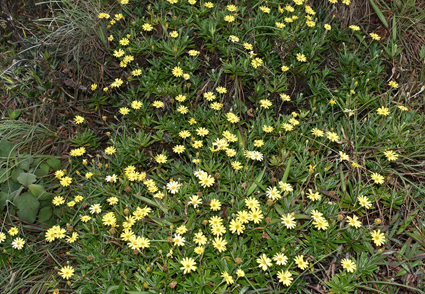Abstract
A new species of Senecio (Asteraceae), S. sisparensis, has been collected from Silent Valley National Park, Palakkad, Kerala, India. It is morphologically close to the species grouped in cluster 24 by Jeffrey et al., most closely similar to S. griffithii; however, it differs in its habit, leaves, capitula, bracts, ray florets and achene characters. Therefore, this new species is described with a detailed description, phenology and conservation status, along with a photographic plate to facilitate easy identification.
References
- Calvo, J., Álvarez, I. & Aedo, C. (2015) Systematics of Senecio section Crociseris (Compositae, Senecioneae). Phytotaxa 211 (1): 1–105. https://doi.org/10.11646/phytotaxa.211.1.1
- Candolle, A.P. de (1834) Compositae. In: Wight, R. (Ed.) Contributions to the botany of India. Parbury, Allen & Co., London, pp. 5–27.
- Clarke, C.B. (1876) Compositae Indicae, Descriptae et Secus Genera Benthamii Ordinatae. W.Thacker & Co., London, pp. 177–210. https://doi.org/10.5962/bhl.title.49202
- Grierson, A. (1980) Compositae. In: Dassanayake, M.D. & Fosberg, F.R. (Eds.) A Revised Handbook to the Flora of Ceylon, vol. 1. Oxford & IBH Publishing Co., New Delhi, pp. 256–262.
- Hooker, J.D. (1881) Compositae. In: Hooker, J.D. (Ed.) The Flora of British India, vol. 3. L.Reeve & Co., London, pp. 219–419.
- IUCN (2022) The IUCN Red List of Threatened Species. Version 2022-2. https://www.iucnredlist.org. (Accessed: 15 February 2023).
- Jeffrey, C. & Chen, Y.-L. (1984) Taxonomic Studies on the Tribe Senecioneae (Compositae) of Eastern Asia. Kew Bulletin 39 (2): 205–446. https://doi.org/10.2307/4110124
- Jeffrey, C., Halliday, P., Wilmot-Dear, M. & Jones, S.W. (1977) Generic and sectional limits in Senecio (Compositae): I. Progress report. Kew Bulletin 32: 47–67. https://doi.org/10.2307/4117259
- Karthikeyan, S., Sanjappa, M. & Moorthy, S. (2009) Flowering plants of India: Dicotyledons, Acanthaceae-Avicenniaceae, vol. 1. Botanical Survey of India, Kolkata, pp. 270–274.
- Karthikeyan, S., Sanjappa, M., Moorthy, S., Bhattacharjee, B., Dash, S.S., Meena, S.L. & Mastakar, V.K. (2020) Senecio. In: Mao, A.A. & Dash, S.S. (Eds.) Flowering Plants of India, An Annotated Checklist (Dicotyledons), vol. 1. Botanical Survey of India, Kolkata. pp. 786–790.
- Linnaeus, C. (1753) Species plantarum. L. Salvius, Stockholm, 1200 pp.
- Mathur, R. (1995) Senecioneae. In: Hajra, P.K., Rao, R.R., Singh, D.K. & Uniyal, B.P. (Eds.) Flora of India, vol. 13. Botanical Survey of India, Calcutta, pp. 186–323.
- Nordenstam, B. (2007) Senecioneae. In: Kadereit, J.W. & Jeffrey, C. (Eds.) The Families and Genera of Vascular Plants, vol. 8. Springer, Berlin, pp. 208–241.
- Nordenstam, B., Pelser, P.B., Kadereit, J.W. & Watson, L.E. (2019) Senecioneae. In: Funk, V.A., Susanna, A., Steussy, T.F. & Bayer, R.J. (Eds.) Systematics, evolution and biogeography of Compositae. International Association for Plant Taxonomy, Vienna, pp. 503–526.
- Pelser, P.B., Nordenstam, B., Kadereit, J.W. & Watson, L.E. (2007) An ITS phylogeny of tribe Senecioneae (Asteraceae) and a new delimitation of Senecio L. Taxon 56 (4): 1077–1104. https://doi.org/10.2307/25065905
- POWO (2023) Plants of the World Online. Facilitated by the Royal Botanic Gardens, Kew. Available from: http://www.plantsoftheworldonline.org/ (Accessed: 3 June 2023).
- Rao, R.R., Chowdhery, H.J., Hajra, P.K., Kumar, S., Pant, P.C., Naithani, B.D., Uniyal, B.P., Mathur, R. & Mamgain, S.K. (1988) Florae Indicae Enumeratia-Asteraceae, Fl. India Series 4. Botanical Survey of India, Calcutta, pp. 67–71.
- Sasidharan, N. (2013) Flowering plants of Kerala: CD-ROM, version 2.0. Kerala Forest Research Institute, Thrissur, Kerala.
- Singh, P., Karthigeyan, K., Lakshminarasimhan, P. & Dash, S.S. (2015) Endemic Vascular Plants of India. Botanical Survey of India, Kolkata.


